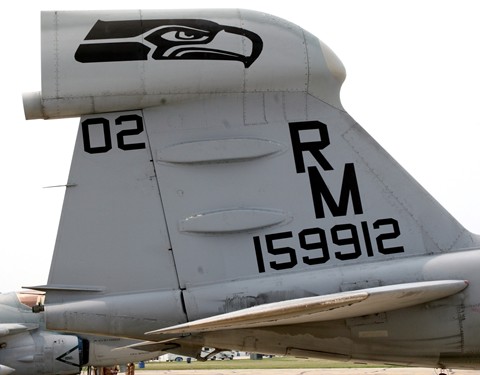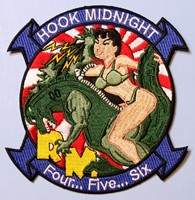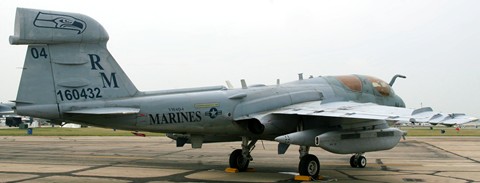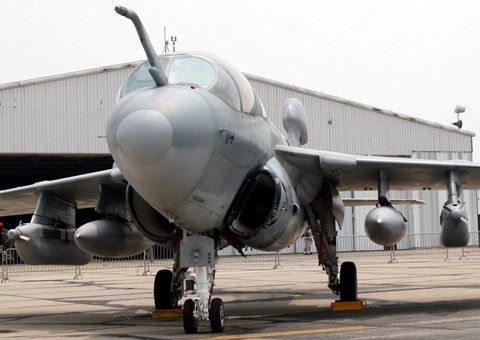|
VMAQ-4, the Seahawks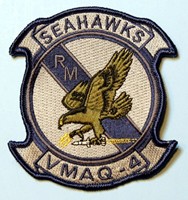
VMAQ-4 is short for US Marine Corps Tactical Electronic Warfare Squadron Four. The outfit currently flies the Grumman EA-6B Prowler. The squadron, nicknamed the Seahawks, is based at Marine Corps Air Station (MCAS) Cherry Point, North Carolina and is attached to Marine Aircraft Group Fourteen (MAG-14), 2nd Marine Aircraft Wing (2nd MAW). Their mission is to Support the Marine Air-Ground Task Force (MAGTF) Commander by conducting airborne electronic warfare, day or night, under all weather conditions during Expeditionary, Joint, or Combined operations. VMAQ-4 is one of four Marine Prowler squadrons assigned to MCAS Cherry Point. OriginsThe squadron's lineage traces back to September 15, 1952, when VMC-1 was established at Pohang-dong, Korea where it flew the Douglas AD-4N Skyraider in combat from 1952 to 1958. On July 31, 1958, at Marine Corps Air Station El Toro, CA, VMC-1 was combined with VMJ-1 flying RF-8A Crusaders, thus forming composite squadron VMCJ-1. This combination, along with the formation of VMCJ-2, provided the Marine Corps with two squadrons that were dedicated to performing electronic warfare and photoreconnaissance missions. The 1960sDuring the new electronics era, VMCJ-1 flew the first carrier-based all weather jet, the Douglas F3D-2Q Skynight, later redesignated the EF-10. Though designed for carrier use, the Skynights flown by VMCJ-1 were operated from Marine Corps Air Station Iwakuni, Japan. VMCJ-1’s Skynights were the only jet powered aircraft to fly combat missions in both Korea and Vietnam. In the early years of Vietnam, the squadron also flew its Vought RF-8A Crusaders in photoreconnaissance missions off the USS Ticonderoga (CVA-14), USS Constellation (CVA-64), USS Coral Sea (CVA-43), and the USS Oriskany (CVA-34). In April 1965, VMCJ-1 took its EF-10B aircraft from Marine Corps Air Station Iwakuni, Japan and joined Marine Aircraft Group 16 at Danang to combat the increase of surface to air missiles in Vietnam. During that same year, six VMCJ-1 EF-10Bs supported the first strike against a surface-to-air missile site in history. The Grumman EA-6A Electric Intruder was introduced in November 1966 at Danang and flew combat missions as far north as Hanoi and Haiphong and eventually replaced the EF-10B Skynight. VMCJ-1 retired its RF-8A Crusaders and received McDonald-Douglas RF-4B Phantom II’s to accomplish the photoreconnaissance mission. 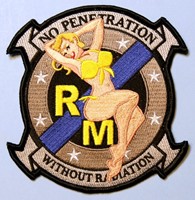
VMCJ-2 and VMCJ-3 also rotated through Danang with the VMCJ squadrons flying electronic attack and photorecon missions for thousands of strike missions for the remainder of the Vietnam War. Photo to the right shows VMAQ-4's Friday patch. Post VietnamAfter the withdrawal of troops from Vietnam, VMCJ-1 was again flying missions from Navy aircraft carriers. From September 11, 1973 to December 31, 1975, VMCJ-1 and VMCJ-1 Detachment 101 conducted missions from the USS Midway (CVA-41), eventually being replaced by VMCJ-2 in December 1975 when the USS Midway returned to her home port. Due to restructuring, the Marine Corps decided to reorganize its squadrons to establish dedicated electronic attack and reconnaissance squadrons. The result was the establishment in July 1974 of VMFP-3 at MCAS El Toro, which would only fly the RF-4B Phantom II. All EA-6A aircraft were reorganized at MCAS Cherry Point, NC under the designation VMAQ-2. In September 1975, VMCJ-1 was disestablished. With the US Navy receiving the newly designed Grumman EA-6B Prowler, the Marine Corps decided to maintain its war proven EA-6A’s until the Prowler Improved Capability (ICAP) aircraft would be produced. In the early 1980s, the Marine Corps began receiving the ICAP EA-6B Prowlers. The growing number of Prowlers forced the Marine Corps to reduce its number of EA-6As. To accomplish this, the Marine Corps moved its EA-6A’s to the Marine Reserves at NAS Whidbey Island, WA. This allowed the Marine Corps to maintain a proven electronic attack asset and on May 21, 1981 VMAQ-4 was established as a reserve squadron at NAS Whidbey Island, WA flying the EA-6A. Many members of the new VMAQ-4 had flown EA-6As in Vietnam while in VMCJ-1, and when the time came to designate a tail code, the members reprised the old Romeo Mike (RM) tail designation as a remembrance of VMCJ-1. Modern DayAfter Operation Desert Storm, VMAQ-2 was divided into three squadrons: VMAQ-1, -2, and -3. VMAQ-4, which had recently received the EA-6B Prowler, was activated and moved to MCAS Cherry Point in 1991 where all four squadrons still remain in service today.
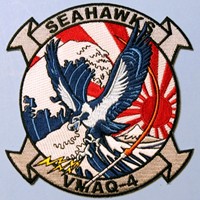
In 2002, VMAQ-4 deployed to Saudi Arabia in support of Operation Southern Watch. Since 1991, VMAQ-4 has completed five West-Pac deployments to Iwakuni, Japan in support of MAG-12’s mission to stabilize the Korean Peninsula and the Western Pacific theater. In 2005, they deployed to Al Asad airbase, Iraq in support of Operation Iraqi Freedom. Photo to the right shows VMAQ-4 West-Pac patch, while the photo below shows the Friday West-Pac patch.
The FutureThe EA-18G Growler, based on the F/A-18F Super Hornet, was scheduled to start replacing the EA-6B beginning in 2009, with the operative word here being ‘start’. Sources tell us that the Prowler is outliving its predicted end, so its usefulness to the Marines may be extended. This is another testament to how well Grumman aircraft are built. With all the military budget cuts it would not surprise us to see the EA-6B around for another ten years or more. Pilots tell us they love flying the Prowler and mechanics tell us it is easy to maintain. Makes you wonder what the ‘heads’ in Washington are doing. We are all for economization in Washington, but this one-size-fits-all mentality does not always work. EA-6B Photos VMAQ-4; Taken at 2007 Dayton Air ShowFirst up, Navy bureau number 159912.
And our other EA-6B Prowler at Dayton was this one, 160432.
Top of this VMAQ-4 page.
|
